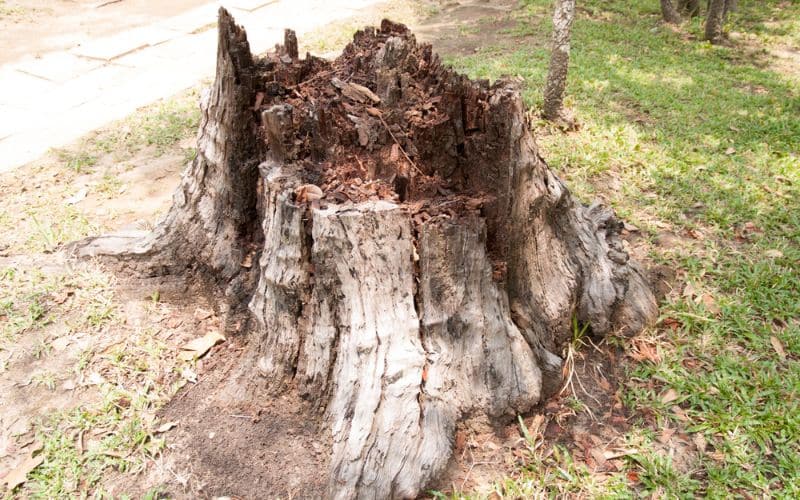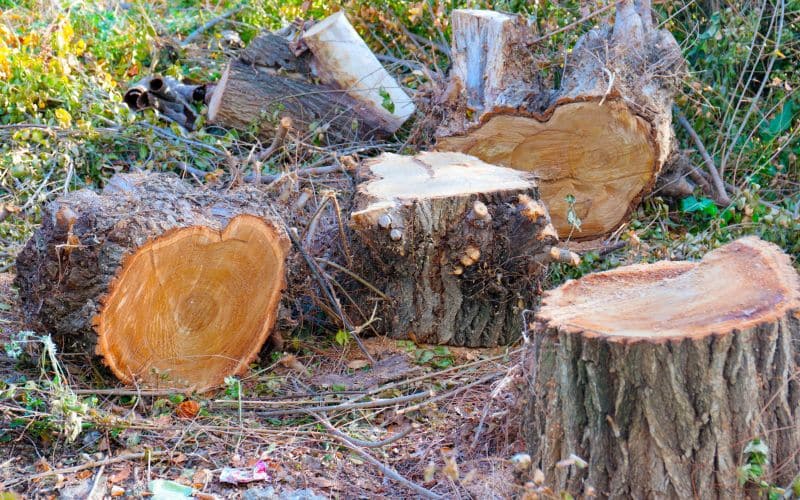
You’ve cut down that troublesome tree, but now you’re left with an unsightly stump, stubbornly clinging to life through its deep roots. You might’ve heard that bleach can be a cheap and easy solution for killing tree roots, but does it really work?
While bleach is known for its powerful cleaning properties, its effectiveness as a tree root killer is a hotly debated topic. Before you pour that bottle of bleach onto your tree stump, let’s explore whether this method is truly the answer to your garden woes or if it could do more harm than good.
Why use bleach to kill tree roots?
When considering methods for tree root removal, bleach stands out due to its availability and familiarity. Virtually every household has bleach, making it a readily accessible option for tackling unwanted tree roots.
Bleach’s primary appeal lies in its potential to hinder root growth. When applied directly, bleach may damage some of the roots it comes into contact with. This effect can buy you time, especially if the invasive roots are causing immediate concerns, such as encroaching on pipes or foundational structures.
Despite its corrosive nature, when used cautiously, bleach won’t typically damage pipes made from resilient materials. This is significant when roots infiltrate sewer lines. By cutting the roots and treating them with bleach, there’s a chance to control the situation temporarily.
Indeed, the resilience of tree roots can lead to mixed results; however, bleach’s impact on softer, less durable roots might provide temporary relief. For a more long-term solution, multiple treatments may be necessary as bleach does not dissolve the roots but can inhibit their ability to absorb nutrients effectively.
Safety precautions when using bleach
When tackling the task of removing tree roots with bleach, it’s paramount to prioritise safety to avert harmful effects on your health and the environment.
Wearing Protective Gear
Upon deciding to use bleach for root removal, it’s essential to don the right protective gear to safeguard yourself:
- Safety Glasses: Protect your eyes from potential splashes, which could lead to severe irritation or damage.
- Long-Sleeved Clothing: Prevent bleach from coming into contact with your skin, causing irritation or burns.
- Gloves: Use chemical-resistant gloves like those made from nitrile or neoprene to prevent direct skin contact.
- Closed-Toed Shoes and Long Pants: Avoid any spills on your feet and legs.
- Respiratory Protection: If working in a poorly ventilated area, wear a mask or respirator to prevent the inhalation of fumes, which can lead to respiratory issues.
Proper Disposal of Bleach
After you’ve completed the task of applying bleach to the tree roots, it’s crucial to dispose of any leftover bleach properly:
- Dilute before disposal: Never pour concentrated bleach into the environment. Always dilute it with a large volume of water to reduce its potency.
- Avoid Drains Leading to Natural Water: Disposing of bleach down drains that lead to lakes, rivers, or oceans harms aquatic life.
- Follow Local Guidelines: Your local waste management services provide specific instructions for disposing of household chemicals like bleach.
By responsibly disposing of bleach, you help protect local ecosystems and abide by environmental safety regulations.

Steps to kill tree roots with bleach
Identifying the Tree Roots
Before you begin the process of killing tree roots with bleach, it’s crucial to pinpoint which roots are causing the problem. Trees transfer nutrients through their outer ring, so look for the live tree tissue, which appears wet after cutting. If it’s dry and looks like dead wood, you need to cut lower. Remember, simply drenching the stump won’t do; you must expose the active parts of the tree for the bleach to be effective.
- Inspect the tree stump and look for live tree tissues.
- Identify branches that are growing out from the stump.
- Confirm that the freshly cut stump looks wet to ensure you’ve reached the live part of the tree.
Preparing the Bleach Solution
To prepare a bleach solution that’s strong enough to tackle tree roots, mix chlorine bleach with water in a 1:1 ratio. Always wear protective gear when handling bleach, as it’s a corrosive substance that can cause health issues, including skin irritation and respiratory problems. Opt for a backpack or handheld sprayer, which allows for a more targeted application, limiting the potential damage to the surrounding soil and environment.
- Dilute concentrated bleach with an equal amount of water.
- Use a backpack or handheld sprayer for application.
- Don protective gear, including gloves, eye protection, and long-sleeved clothing.
Applying the Bleach to the Tree Roots
For smaller plants, cut them to the stump and apply the bleach solution directly to the stump and any exposed roots. For larger trees, after reducing them to a stump, create gashes around its circumference and drench the gashes with the bleach solution. This method, known as the Cut Surface Treatment, ensures the bleach gets into the live tissue of the tree, hindering the tree’s ability to transfer nutrients and effectively killing the roots over time.
- Cut the tree down to the stump for better bleach application.
- Make gashes around the tree stump’s circumference using an axe.
- Apply the bleach solution generously to cover the stump and the fresh gashes.
Remember, while bleach may dehydrate the area and prevent some nutrient transfer, it doesn’t invade the tree’s system in the way traditional herbicides would. To fully ensure that the tree roots are killed, you may have to repeat the application after a couple of weeks. Additionally, bear in mind that bleach can alter the pH of soil, potentially making it difficult for new vegetation to grow. After using bleach, you might have to take additional steps to rehabilitate the soil for future planting.

Alternatives to using bleach
When looking to rid your garden of tree roots, consider options beyond bleach. The right alternative for you may depend on several factors including environmental impact, labour intensity, and the need for a long-term solution.
Natural Remedies for Killing Tree Roots
Opting for natural methods to kill tree roots is a choice favoured for its minimal impact on the surrounding ecosystem. Here are some options:
- Rock Salt: Applying rock salt is an effective method. It dehydrates plant cells, thus killing the roots. You’ll need about 900 grams of rock salt distributed around the stump and roots. It’s important to follow up with a second round after two weeks to ensure effectiveness.
- Epsom Salt: Rich in magnesium and sulfur, Epsom salt can be used to create a lethal solution for tree roots. Mix 15 cups of Epsom salt with 11 litres of water and apply it to drilled holes in the roots. This method gradually dries out the roots.
- Copper Sulfate: Utilise copper sulfate to target the roots directly. Apply the compound into holes around the root system, but be aware: this substance can be toxic to aquatic life and should be used carefully.
Mechanical Removal of Tree Roots
For immediate results, mechanical removal may be your preferred alternative:
- Stump Grinding: Using a stump grinder will quickly reduce a stump to wood chips, including any surface roots. This process can take between 2 to 6 hours depending on stump size.
- Root Cutting: Manually cutting the roots, either by hand tools or a chainsaw, can sever the life source to the stump. It’s labour-intensive but it physically removes the problem.
Remember, mechanical methods can vary greatly in terms of effort and cost. Consider the size of the tree stump and your budget before proceeding. It’s important to note that while effective, mechanical removal methods generally require more safety considerations due to the use of heavy machinery or sharp tools.
Conclusion
You’ve explored the method of using bleach to tackle unwanted tree roots yet you’re also armed with alternative natural and mechanical solutions. Remember to weigh the environmental consequences and the effort required before choosing your approach. Whether you opt for a natural remedy like rock salt or a more hands-on technique like stump grinding your decision should align with your specific situation and long-term landscaping goals. Now you’re ready to reclaim your garden’s harmony with the knowledge to make an informed choice.
Colin Macmillan is a seasoned entrepreneur and the CEO of Riverwood Landscape, a leading landscaping company based in Canada. He has been at the helm of the company since leaving high school, demonstrating his strong leadership skills and business acumen.
Colin’s expertise lies in various aspects of landscaping, including lawn care, interlocking, sod installation, and commercial maintenance. His hands-on approach and dedication to the craft have been instrumental in building Riverwood Landscape into a reputable brand.
One of his most notable achievements is the creation of a successful landscape franchise that services multiple locations. This accomplishment underscores his strategic thinking and ability to scale operations effectively.
Colin has also had the privilege of working with Guelph Hospital for landscaping and maintenance, a testament to the trust and reliability that his company has earned over the years.
His professional mission is to offer the best services and experiences for customers, a goal that he tirelessly pursues. Colin’s commitment to excellence and customer satisfaction continues to drive the growth and success of Riverwood Landscape.








